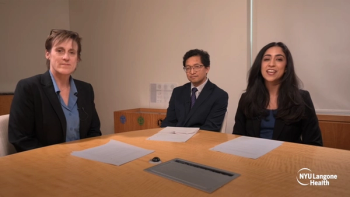
Vitrectomy helpful before macular hole development
Detecting a macular hole or photoreceptor detachment is critical for obtaining good surgical results in patients with myopic foveoschisis.
Hong Kong-Detecting a macular hole or photoreceptor detachment is critical for obtaining good surgical results in patients with myopic foveoschisis, said Yasushi Ikuno, MD, at the retina subspecialty day of the World Ophthalmology Congress.
Patients with the foveal detachment type of myopic foveo-schisis seem to benefit the most from vitrectomy, said Dr. Ikuno, assistant professor, Department of Ophthalmology, Osaka University Medical School, Osaka, Japan. Spectral-domain optical coherence tomography (SD-OCT) and fundus autofluorescence (FAF) are valuable for managing the condition in these patients.
Myopic foveoschisis, he explained, usually occurs in older women with high myopia, and it can result in loss of vision and metamorphopsia. Vitrectomy improves the vision and presents development of a macular hole with retinal detachment.
"Different flexibility between the inner and outer retina associated with axial length elongation is thought to be pathogenetic," Dr. Ikuno said. "Factors that may contribute are vascular sclerosis and the internal limiting membrane. An epiretinal membrane also limits the inner retinal stretching."
Three groups
He and colleagues classified patients with myopic foveoschisis into groups based on the foveal status: the foveal schisis type has photoreceptors still attached to the retinal pigment epithelium (RPE), the foveal detachment type is characterized by a foveal detachment from the RPE, and the macular hole type has a full-thickness retinal defect at the fovea.
"The natural course of foveoschisis is quite poor-about half of the patients develop a macular hole or retinal detachment within 3 to 4 years," Dr. Ikuno said. He demonstrated with OCT the progression of the disease from the foveal schisis type to the end stage macular hole, which is a full-thickness defect at the fovea.
During surgical intervention, he said, he and his colleagues apply triamcinolone and peel the vitreous cortex that adheres to the retina. They then perform indocyanine green-internal limiting membrane peeling followed by fluid-air exchange.
Results for each of the subtypes following vitrectomy indicated that those patients with the foveal detachment type had the most favorable outcome, with about 80% of patients having an improvement in visual acuity. About 50% of patients with the foveal schisis type had a visual improvement. Only 30% of those with the macular hole type had an improvement in vision; 30% had a decrease in the visual acuity.
Surgical results
Dr. Ikuno discussed the surgical results in eight eyes that had the most severe form: the macular hole type.
"Macular hole closure was achieved in only 25%. The best-corrected visual acuity improved in 25%, remained unchanged in 37.5%, and worsened in 37.5%," he said.
"It is too late for pars plana vitrectomy after a macular hole has developed," Dr. Ikuno continued. "Preventive treatment must be done in earlier stages. Only two of eight patients with a macular hole had improved vision; the vision remained unchanged or worsened in the remaining six patients."
When he and his colleagues compared the results between the patients with the foveal schisis type with the foveal detachment type, findings indicated that vitrectomy was more beneficial for the patients with the foveal detachment type.
"Interestingly, patients with the foveal detachment type had significantly better vision than those with the foveal schisis type at the final visit. Thus, vitrectomy is more beneficial for the former group," he noted.
"When treating patients with the foveal schisis type," he advised, "surgeons can wait until a foveal detachment occurs, because the surgical effect is limited. For patients with the foveal detachment type, surgery should be performed as soon as possible before a macular hole develops. This is the golden opportunity for treating patients."
Dr. Ikuno continued, "For patients with the macular hole type, the surgical effects are limited. However, surgery is still meaningful in terms of preventing an extensive retinal detachment that can lead to blindness. Detecting a macular hole is critical to predicting the surgical results."
Management techniques
SD-OCT and FAF are new techniques to manage myopic foveoschisis, he said, recommending them. SD-OCT is able to detect macular holes that were undetectable by B-scans of conventional time-domain OCT, Dr. Ikuno said, and FAF can show the photoreceptor status as two-dimensional information.
To underscore the importance of imaging in the management of these patients’ conditions, he presented the case of a 66-year-old woman with the macular hole type.
"A three-dimensional SD-OCT scan is quite useful for detecting the pathology outside the fixation point," Dr. Ikuno said. "In this case, the macular hole was overlooked in five-line parallel B-scans."
When using FAF, the investigators found that the FAF signal indicates the photoreceptor status of the macula. For instance, a detachment results in hypo-FAF in the presence of subretinal fluid.
Dr. Ikuno was joined in this study by Yuko Morimoto, MD; Kaori Sayanagi, MD; Kaori Soga, MD; and Yasuo Tano, MD.
Newsletter
Don’t miss out—get Ophthalmology Times updates on the latest clinical advancements and expert interviews, straight to your inbox.













































